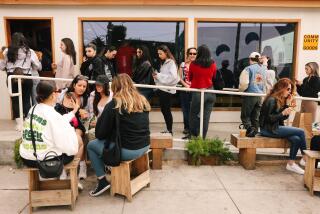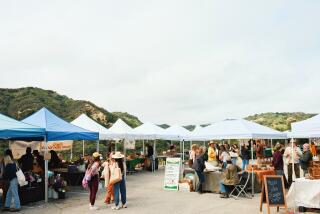Market Match helps get fresh produce to low-income farmers market shoppers

A shopper pays for fresh produce with Market Match at the Adams-Vermont market.
At 2 p.m. Wednesday, farmers at the Adams-Vermont growers’ market were busily popping up tents, setting up tables and unloading fruits and vegetables, getting ready to open.
But Frank Tamborello and his team were already in mid-market mode. They had to be. There were already 30 to 40 people in line waiting for them.
Tamborello’s group doesn’t sell peaches or strawberries or even kale. Instead, it helps administer a program called Market Match that since 2009 has been rewarding low-income shoppers with up to a $10 bonus for buying fresh produce at farmers markets.
Funded by a mix of grants, including $2.5 million over the next five years from First 5 LA, Market Match provides vouchers for SSI, EBT and WIC recipients to use while shopping at participating farmers markets.
In the Los Angeles area, that includes 20 markets — 15 administered by Tamborello’s Hunger Action Los Angeles, and five administered by Sustainable Economic Enterprises-Los Angeles — with more scheduled to come on through the summer.
Tamborello says the goal is to have every market in Southern California that takes EBT (short for Electronic Benefit Transfer) to also take Market Match, which would be about 60 markets.
The Adams-Vermont market, held on the parking lot at Saint Agnes Catholic Church on West Adams Boulevard, was one of the first farmers markets in Southern California, and was one of the first to offer Market Match.
It serves a predominantly low-income clientele and, compared to many markets, is small — with fewer than a dozen vendors. But when it’s running, it is action-packed, with as many as 1,200 shoppers crowding in elbow-to-elbow for the four hours it’s open.
Harry Brown-Hiegel, who recently returned to managing the market after having helped open it in 1980 — when he was a priest at the church — says more than 90% of the eligible shoppers at Adams-Vermont use Market Match.
“The word’s out and they know about the program and that’s part of the reason they come,” Brown-Hiegel says. “They look forward to the value they get at the market in terms of quality and with the incentive it makes it even more attractive.
“People buying good food for young families, that’s the best there is.”
Even before the market officially opens, the Hunger Action crew, clad in orange T-shirts, is out shepherding people into the appropriate lines and informing shoppers they think might qualify for help of what’s available.
Tamborello says shoppers at the Adams-Vermont market use about $1,100 in Market Match vouchers a week. “Total all of our markets together and you’re talking about $30,000 a month,” he says.
Last year HALA distributed about $360,000 for Market Match; this year’s total should be at least $400,000, Tamborello says.
New shoppers are coming on board every week. LaTasha Evans recently lost her real estate job when her boss died. New to the benefits game, she researched her options thoroughly. “When I found out about Market Match, I was like ‘I’m on it!’” she says.
The sign-up process was easy, Evans says. “It went fairly quick. They were very friendly and helpful and they didn’t make me feel strange about it.”
Wednesday she had filled her bags with chard, purple kale, butter lettuce, strawberries, plums, avocados and orange juice.
“This gives me an opportunity to make sure my children are eating healthy food,” says the 44-year-old mother of four. “I’ve got a 17-year-old daughter who is highly active in sports and cheer and you can guess how hungry she is when she comes home.”
The program benefits not only shoppers, but California’s many small farmers as well. In a survey conducted by Market Match in 2013, 80% of farmers at participating markets reported that they sold more fruits and vegetables, and 66% said that they had made more money, as a result of the program.
The way Market Match works is shoppers collect farmers market script on their EBT cards, then they go to the Market Match table and collect their matching script, up to $10 per family per week. SSI and WIC participants can collect their match on cash.
The funding for the program comes from a complex variety of sources, each with its own requirements, which makes bookkeeping a bit of a headache.
The First 5 LA funding, for example, can only go to people with children under 5 years old, mostly WIC recipients. Another large grant comes from the USDA’s Food Insecurity Nutrition Incentive (FINI) program, which helps people getting EBT.
But those two combined only cover about two-thirds of recipients, Tamborello says. The rest of the funding comes from a variety of smaller grants.
One much-hoped-for source, a $2.5-million appropriation approved by the Legislature, was not included in Gov. Jerry Brown’s final budget proposal. Assembly Bill 1321, seeking to establish funding for programs such as Market Match, is still alive.
Shopper Laura Gutierrez has lived in the West Adams neighborhood 11 years and works for a nonprofit ministry in the area. She says that without a Trader Joe’s or Whole Foods nearby, the farmers market is one of the best sources of fresh produce she has.
“Being a low-income family, the Market Match program helps stretch our budget, allowing us to buy good, healthy food, right in our neighborhood,” she wrote in an email.
“Not only are we getting delicious, fresh, straight-from-the-farm produce and eggs, but now the price is cut in half! Why would I want to buy from a grocery store when all these benefits are available to me at this market, with this program? We love it and are continually thankful for it!”
Are you a food geek? Follow me on Twitter @russ_parsons1
More to Read
Eat your way across L.A.
Get our weekly Tasting Notes newsletter for reviews, news and more.
You may occasionally receive promotional content from the Los Angeles Times.







